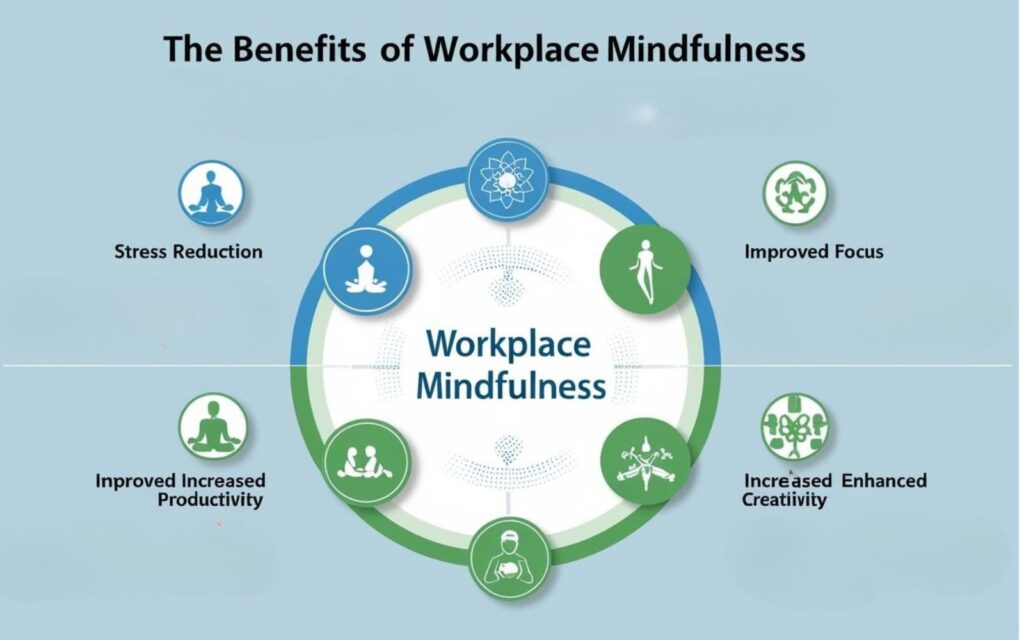Mindfulness Practices for Workplace Wellness: Your Path to a Healthier Workday By 9 Steps

Do you ever feel overwhelmed at work, like tasks are piling up and you can’t focus? You’re not alone! Workplace stress is rising, and employee well-being is more important than ever.
The good news is that mindfulness practices for workplace wellness can help you feel calmer, more focused, and energized throughout your day. These practices effectively reduce stress and enhance physical and mental health.
Mindfulness isn’t just about meditating in silence- about being fully present in the moment and incorporating mindful habits into your routine.
This article explores mindfulness exercises that are easy to implement and can enhance both work-life balance and productivity.
Key Takeaways
- Mindfulness in the workplace improves focus, reduces stress, and enhances well-being.
- Daily mindfulness practices, such as breathing exercises and mindful meditation, can reduce perceived stress.
- Mindfulness training programs can boost employee engagement and create a more positive workplace culture.
- A holistic approach that includes mindful leadership and stress reduction techniques supports employee wellness and mental health.
Let’s dive into how you can bring mindfulness to your workday!
What is Mindfulness in the Workplace?

Mindfulness in the workplace is about being fully present and engaged in the current moment while cultivating non-judgmental awareness of your thoughts, feelings, and bodily sensations.
It means paying attention to the present moment with openness, curiosity, and a willingness to accept things as they are.
By incorporating mindfulness into your workday, you can develop greater self-awareness, improve your ability to manage stress and enhance your overall well-being.
This practice helps you stay grounded, making navigating the challenges of a busy work environment easier with a calm and focused mind.
Benefits of Workplace Mindfulness

The benefits of workplace mindfulness are numerous and well-documented, making it a valuable practice for any organization. Here are some of the most significant advantages:
- Reduced Stress and Anxiety: Mindfulness practices have been shown to decrease the production of stress hormones, such as cortisol, leading to lower levels of anxiety and stress. This helps create a more relaxed and productive work environment.
- Improved Focus and Productivity: By training your mind to stay present and focused, you can enhance your ability to concentrate and stay on task. This increases productivity and efficiency, allowing you to accomplish more with less effort.
- Enhanced Creativity and Innovation: Mindfulness practices can boost creativity, improve problem-solving skills, and foster innovation. When your mind is clear and focused, you’re better equipped to think outside the box and develop new ideas.
- Better Communication and Collaboration: Practicing mindfulness can help you develop greater empathy and understanding, leading to improved communication and collaboration with colleagues. This fosters a more supportive and cohesive team environment.
- Improved Employee Well-Being: Mindfulness practices have increased happiness, life satisfaction, and well-being. Employees who feel good are more engaged and motivated, contributing to a positive workplace culture.
1. Start Your Day With a Mindful Morning Routine

How you start your morning impacts your entire day. Incorporating mindfulness into your morning routine sets a calm, focused tone for work.
Mindfulness Exercises for Your Morning:
- Mindful Breathing: Take a few deep breaths before opening emails or starting meetings. Inhale for a count of four, hold for four, and exhale slowly.
- Set an Intention: Consider what you want to focus on for the day (e.g., “I will practice mindfulness and be fully present during meetings”).
- Avoid Distractions: Keep your phone notifications off during your first work tasks to stay centered.
Introducing mindfulness early in your day helps reduce stress, making navigating the challenges of a busy work environment easier and improving your productivity.
2. Practice Mindful Breathing During Stressful Moments

Mindfulness-based stress reduction often starts with something simple your breath. Taking a few deep breaths can calm your nervous system and help you regain focus.
How to Practice Mindful Breathing:
- Close your eyes or soften your gaze.
- Inhale deeply, noticing any physical sensations as the air fills your lungs.
- Exhale slowly, focusing on how your body feels.
- Repeat this process for 1–2 minutes.
Mindfulness research suggests that mindful breathing can lower cortisol levels, reduce stress, and improve sleep quality, making it an essential part of any workplace wellness program.
3. Mindful Leadership: Creating a Calm, Supportive Workplace

A mindful leader sets the tone for a supportive, balanced work environment. Leaders who model mindfulness help their teams develop healthy behaviors and resilience.
Mindful Leadership Practices:
- Active Listening: Be fully present in conversations. Avoid distractions and show empathy.
- Encourage Mindfulness Breaks: Promote short mindfulness meditation breaks for your team to reset during busy workdays.
- Lead by Example: Share your mindfulness journey and encourage employees to implement mindfulness practices without fear of judgment.
By implementing mindfulness as part of leadership presence, you foster trust, employee engagement, and greater job satisfaction.
4. Mindful Working: Focus on One Task at a Time

Multitasking often increases perceived stress rather than productivity. Workplace mindfulness involves focusing on one task at a time with full attention.
Tips for Mindful Working:
- Single-Tasking: Close unrelated tabs and focus only on the task at hand.
- Pause Between Tasks: Take a deep breath and reset your focus before starting a new task.
- Mindful Emailing: Before sending an email, pause for a few seconds to review its tone and clarity.
This mindful approach reduces errors, improves task quality, and helps reduce stress, enhancing your overall work-life balance.
5. Walking Meditation: Refresh Your Mind and Body

Sitting for long periods can affect both your mental health and physical well-being. Walking meditation is a simple mindfulness practice that helps you recharge.
How to Practice Walking Meditation:
- Stand and take a few deep breaths before you begin.
- Walk slowly and pay attention to your bodily sensations, like the pressure of your feet on the ground.
- Focus on each step and how your body feels as you move.
- If your mind wanders, gently bring your attention back to your steps.
Walking meditation combines movement and mindfulness, helping you reduce stress levels and increase clarity.
6. Incorporate Mindfulness-Based Interventions for Team Wellness

Mindfulness-based cognitive therapy and stress reduction programs have improved employee health and well-being. These mindfulness programs can be introduced as part of an employee wellness program.
Mindfulness Programs for Workplace Wellness:
- Guided Practices: Use apps like Headspace or Calm for short, guided meditations.
- Mindfulness Initiatives: Encourage leadership institutes or HR departments to host workshops that raise workplace mindfulness awareness.
- Personal Development Resources: Share tools for daily practice, including breathing exercises and mindfulness journals.
When companies invest in mindfulness-based interventions, they create a healthier, more productive workplace culture.
7. Mindful Listening for Stronger Connections

Mindful listening strengthens team communication and reduces misunderstandings. You’re fully present in the conversation when you practice mindfulness while listening.
How to Practice Mindful Listening:
- Focus on the Speaker: Give your full attention without considering your response.
- Avoid Interrupting: Pause and absorb the message before speaking.
- Acknowledge Without Judging: Nod or give verbal affirmations without rushing to conclusions.
Mindfulness skills like active listening build better relationships and increase employee well-being.
8. Gratitude and Reflection: End Your Day Mindfully

End your workday on a positive note by reflecting on what went well. Practicing gratitude can improve your mood and reduce workplace stress.
How to Practice Mindful Gratitude:
- Write down three things you’re grateful for at work (e.g., “I completed my presentation” or “I felt supported by my team today”).
- Reflect on your small wins and acknowledge your progress.
- Take deep breaths as you transition from your workday to your personal life.
Positive psychology research suggests that gratitude practices can improve overall well-being and sleep quality, making it a great addition to your mindfulness routine.
9. Success Stories and Case Studies

Numerous success stories and case studies highlight the effectiveness of mindfulness in the workplace. Here are a few notable examples:
- Aetna: This health insurance company implemented a mindfulness program that resulted in a 28% reduction in stress levels and a 20% increase in employee engagement. The program helped employees feel more relaxed and focused, leading to better performance and job satisfaction.
- Google: Known for its innovative culture, Google offers a mindfulness program called “Search Inside Yourself.” This program has been shown to increase employee well-being and reduce stress, helping employees stay balanced and productive in a fast-paced environment.
- Intel: Intel’s mindfulness program yielded a 200% return on investment and significantly reduced employee stress levels. The program’s success demonstrates the tangible benefits of investing in employee well-being.
- SAP: This software company offers a mindfulness program that has been shown to increase employee well-being and reduce stress. SAP has created a more supportive and productive workplace culture by prioritizing mindfulness.
These success stories and case studies demonstrate the potential of mindfulness to improve employee well-being, reduce stress, and increase productivity in the workplace.
By incorporating mindfulness programs, companies can create a healthier, more engaged, and more innovative workforce.
Summary
Mindfulness practices for workplace wellness don’t have to be time-consuming. Small steps can lead to significant changes, whether it’s mindful breathing, walking meditation, or mindful leadership.
Employees who feel supported through mindfulness initiatives and wellness programs experience greater job satisfaction, reduced stress, and improved mental health.
You’re taking meaningful steps toward a healthier workplace culture by implementing mindfulness in your daily routine.
Frequently Asked Questions
How Does Mindfulness Improve Workplace Wellness?
Mindfulness improves workplace wellness by helping employees stay present, manage work stress, and enhance focus.
Research suggests it also lowers perceived stress and boosts emotional resilience.
What Are Easy Ways to Practice Mindfulness at Work?
Easy mindfulness exercises include deep breathing, body scans, mindful listening, and walking meditation.
These exercises take only a few minutes but are highly effective in reducing stress levels significantly.
Can Mindfulness Programs Improve Employee Engagement?
Yes! Mindfulness-based interventions, such as meditation programs and leadership initiatives, foster employee engagement by improving work-life balance and communication.
How Can Mindfulness Reduce Employee Stress?
Mindfulness helps regulate physical sensations and emotions, lowering cortisol levels and calming the mind.
Mindful behaviors, like focusing on one task at a time, also prevent burnout and overwhelm.
What’s the Role of Mindful Leadership in Employee Wellness?
Mindful leaders create a safe, supportive space for employees by encouraging open communication, promoting mindfulness training, and setting examples for work-life balance.






2 Comments